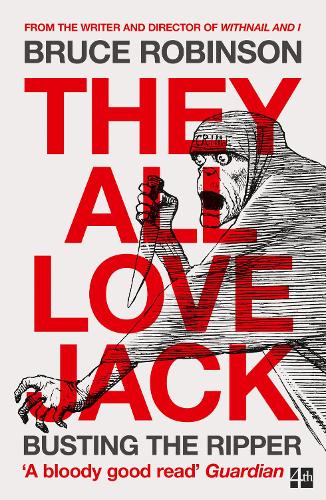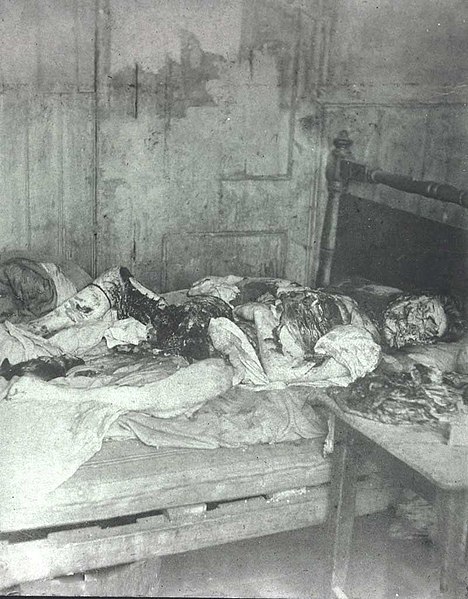Just when you thought this blog couldn’t get any more exciting, I’ve decided to add a few book reviews to really push the reader over the edge! I enjoy reading history books, and I’ve just finished a fascinating 760 page tome examining the possible links between Freemasonry and that lovable rogue known to posterity as Jack the Ripper. And I’m off the drink for Lent so I’ve got nothing else to do. So without further ado, here’s my rambling thoughts on Bruce Robinson’s They All Love Jack (2015).

In a nutshell, this is a fascinating book that attempts to expose the mystery around the world’s most infamous serial killer, mainly by asserting that the reason we still don’t know the true identity of the killer is because it benefited powerful people at the highest realms of Victorian society at the time. And furthermore, that it nowadays suits what has become known as Ripperology…..the study of the crimes and the killer…….to perpetuate the mystery. From the start, Bruce Robinson is very angry, and he mocks the idea that nobody knew the identity of Jack or that the police were incapable or incompetent. He also derides the notion that Jack was some kind of out of control dribbling maniac:
‘You don’t have to be insane to cut people up, no matter how fiendishly you do it. You just have to hate enough’.
‘If the Ripper got hold of you, you were dead. He overwhelmed an entire society, let alone his victims. Apart perhaps from Mary Jane Kelly (and that’s a big perhaps), there were no defensive injuries, not even a moment to hurl a scream at the night. He owned you. You were dead’.

Robinson spends the early parts of this work examining Victorian values and what he perceives as the hypocrisy of the era that produced this individual – ‘politics is reducible to that last defining question: who do you prefer, our liars or theirs?’ He takes aim at the inequities of the class system and the horrendous living conditions of the East London slums in the late 19th century. Robinson highlights the fact that many so-called gentlemen often travelled into the less well off parts of the city to indulge in whatever vices floated their own particular boats, including drug abuse and prostitution. Therefore, in this interpretation Jack the Ripper was a literal manifestation of the moral bankruptcy and hypocrisy of the age.
The basic premise of the main body of this work is that the author believes there has been a more than century long conspiracy to cover up the identity of Jack the Ripper. Why? Because instead of being the insane out of control drooling psychopathic idiot he has often been portrayed as, he was actually a very sane and incredibly dangerous man who also happened to be a member of the upper classes and a Freemason, something he had in common with the leaders of Victorian society. Robinson believes the Ripper to have been ‘a totally sane, highly intelligent psychopath whose sense of fun animated in some esoteric area of his thinking where humour and homicide collide’. Robinson further claims that Jack was sending a message, as all of the crime scenes were rich with Masonic symbolism that had to have been understood by the men hunting the Ripper, given that they were also Freemasons – ‘no serial killer worth the name is going to leave homicidal garbage lying around a crime scene as Jack the Ripper did. He was tossing Freemasonry about like confetti’. In short, Robinson asserts that the people charged with capturing Jack had too much to lose by doing so, as to expose him would be to threaten the very foundations of the elitist and class structured society in which they resided at the highest levels.

Robinson does not spare the reader the horror of the events of 1888:
‘Murder is ugly. When the assassin remains a mystery we see only his debris, the blood and the fatal misery, the hideousness of the victim in death. Murder shocks, and in the case of the Ripper it utterly degrades. Sexual ugliness is its trademark’.
This is most apparent in the picture taken in the bedroom of Mary Jane Kelly following the discovery of her remains on November 9th, which retains its ability to horrify over 130 years later. If you are of a delicate disposition, look away now…..

That is an actual police photograph from the day after the murder of one of the Ripper’s victims. When you see what this animal did to her, it becomes a little harder to buy into the ‘not a lunatic’ theme. There was an incredible amount of hate at play here. Uplifting stuff indeed.
So, spoiler alert……………Robinson identifies his candidate as Jack to have been a man named Michael Maybrick. Maybrick was a famous Victorian song-writer and singer, better known by his pseudonym Stephen Adams……one of his hit songs was called ‘They All Love Jack’. Somewhat unusually this man’s brother James, also a Freemason, has previously been suspected of having been the Ripper. James Maybrick died in 1889, and his wife Florence (what do you mean it’s a woman’s name?) was later convicted of his murder. Robinson further posits that Jack’s hatred towards women was motivated in the main by his sister in law Florence Maybrick, who allegedly had rejected his advances while having affairs with other men, including his brother Edwin. It is Robinson’s thesis that Michael Maybrick, aka Jack the Ripper, rounded off his murderous career with the poisoning of his brother and the framing of his sister in law before retiring to the Isle of Wight!!

Yes I know……it all sounds a bit mental. There is however, a huge breadth of research in this work……which it is impossible to do justice to in a brief blog post……and it is extremely convincing in its conclusions. Though he does seem to stretch credibility somewhat at certain points, overall this is a fantastically well written and researched piece of work, and Robinson presents more than enough evidence to prove his theory. Probably could have done all that in about 200 less pages though. He is also very enraged throughout the narrative, and expresses his anger at everything from the perceived corruption of the police to Victorian hypocrisy to Ripperologists and of course Jack himself. Robinson is also clearly not a fan of Political Correctness (a man after my own heart) and the language is blunt and honest. All in all well worth a read.
So I hope you’ve enjoyed this review, and maybe you might take on this work for yourself. It’s my favourite type of history…..an interesting narrative, well written, without over complicating things in an attempt to sound more intelligent. Next time, I’ll review whatever book I’ve just finished…..unless the coronavirus mysteriously disappears and the pubs reopen unexpectedly…..in which case I may not be seen for weeks.